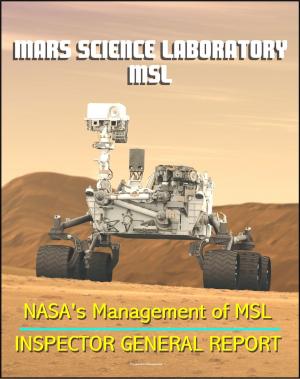Wallops Station and the Creation of an American Space Program: Sputnik, NASA, and Independence, Manned Space Flight, Mercury, Space Science Research, TIROS, V-2 to Sounding Rockets
Nonfiction, Science & Nature, Technology, Aeronautics & Astronautics, Science, Physics, Astrophysics & Space Science| Author: | Progressive Management | ISBN: | 9781310954474 |
| Publisher: | Progressive Management | Publication: | May 5, 2015 |
| Imprint: | Smashwords Edition | Language: | English |
| Author: | Progressive Management |
| ISBN: | 9781310954474 |
| Publisher: | Progressive Management |
| Publication: | May 5, 2015 |
| Imprint: | Smashwords Edition |
| Language: | English |
Professionally converted for accurate flowing-text e-book format reproduction, this unique and informative history covers the political, administrative, and social aspects of the Wallops Station from 1957 to 1966. This period began with the launch of the Soviet Union's Sputnik 2, continued through the creation of NASA, and culminated at the height of the Project Apollo escalation. A fast-paced era, it also includes the second of the three most important periods in Wallops history to date. NASA's Wallops Flight Facility has, since its establishment in 1945, launched over 14,000 rockets, making it one of the most prolific launch sites in the world as well as one of the least known. Currently a subsidiary of Goddard Space Flight Center, Wallops has always been among the smaller of America's aerospace research facilities. Despite, and possibly because of, the administrative and budgetary chaos that often characterized this nation's space effort, Wallops evolved from a highly specialized, test facility to a more generalized, multi-faceted research center. The history of the base reaches back to the early days of U.S. involvement in space research, and reflects most of the major controversies encountered therein. An historical examination of the base, therefore, has value not only because of the comparative lack of such attention, but also because it allows a unique vantage point from which to view what is, to paraphrase policy historian John Logsdon, "the great adventure of our lifetime."
CHAPTER I - INTRODUCTION * CHAPTER II - SPUTNIK, NASA, AND INDEPENDENCE * CHAPTER III - PILOTED SPACE FLIGHT * CHAPTER IV - SPACE SCIENCE RESEARCH * CHAPTER V - CHANGES AMID CONSTANCY
This book is arranged in five chapters, with this first serving to provide background information on the base, relate events leading up to the creation of NASA, and introduce most of the themes that run through the body of the work. The second chapter discusses the founding of NASA, the subsequent expansion of Wallops, and the organization of the base as an independent administrative entity. During this immediate post-Sputnik era the differing prioritization of aeronautical and space science research within NASA began to fundamentally alter Wallops' mission. The sudden appearance of a space race, combined with the unexpected closure of a nearby military base, also shifted the relationship between the station and the local community. Chapter three provides a look at Wallops' involvement with the U.S. piloted space flight effort. This involvement, heavy during Project Mercury, declined throughout the period until almost nil during Project Apollo. The staff's reaction to the novelty of press coverage and public interest in its operations, a side effect of the piloted programs, is also examined. Chapter four traces the course of space science research at Wallops by discussing not only programs and facilities located at the Virginia base, but also those operations that occurred off-range at various locations. Wallops' significant role in NASA's program of international cooperation coalesced during this early period, and is also examined. The final chapter explores how the period of relative stability at Wallops through the following decade, extended from changes (and non-changes) that occurred during the transition era.
Professionally converted for accurate flowing-text e-book format reproduction, this unique and informative history covers the political, administrative, and social aspects of the Wallops Station from 1957 to 1966. This period began with the launch of the Soviet Union's Sputnik 2, continued through the creation of NASA, and culminated at the height of the Project Apollo escalation. A fast-paced era, it also includes the second of the three most important periods in Wallops history to date. NASA's Wallops Flight Facility has, since its establishment in 1945, launched over 14,000 rockets, making it one of the most prolific launch sites in the world as well as one of the least known. Currently a subsidiary of Goddard Space Flight Center, Wallops has always been among the smaller of America's aerospace research facilities. Despite, and possibly because of, the administrative and budgetary chaos that often characterized this nation's space effort, Wallops evolved from a highly specialized, test facility to a more generalized, multi-faceted research center. The history of the base reaches back to the early days of U.S. involvement in space research, and reflects most of the major controversies encountered therein. An historical examination of the base, therefore, has value not only because of the comparative lack of such attention, but also because it allows a unique vantage point from which to view what is, to paraphrase policy historian John Logsdon, "the great adventure of our lifetime."
CHAPTER I - INTRODUCTION * CHAPTER II - SPUTNIK, NASA, AND INDEPENDENCE * CHAPTER III - PILOTED SPACE FLIGHT * CHAPTER IV - SPACE SCIENCE RESEARCH * CHAPTER V - CHANGES AMID CONSTANCY
This book is arranged in five chapters, with this first serving to provide background information on the base, relate events leading up to the creation of NASA, and introduce most of the themes that run through the body of the work. The second chapter discusses the founding of NASA, the subsequent expansion of Wallops, and the organization of the base as an independent administrative entity. During this immediate post-Sputnik era the differing prioritization of aeronautical and space science research within NASA began to fundamentally alter Wallops' mission. The sudden appearance of a space race, combined with the unexpected closure of a nearby military base, also shifted the relationship between the station and the local community. Chapter three provides a look at Wallops' involvement with the U.S. piloted space flight effort. This involvement, heavy during Project Mercury, declined throughout the period until almost nil during Project Apollo. The staff's reaction to the novelty of press coverage and public interest in its operations, a side effect of the piloted programs, is also examined. Chapter four traces the course of space science research at Wallops by discussing not only programs and facilities located at the Virginia base, but also those operations that occurred off-range at various locations. Wallops' significant role in NASA's program of international cooperation coalesced during this early period, and is also examined. The final chapter explores how the period of relative stability at Wallops through the following decade, extended from changes (and non-changes) that occurred during the transition era.















